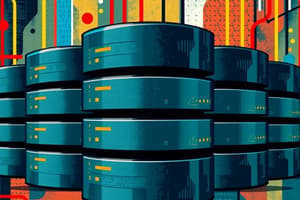Podcast
Questions and Answers
What is a database?
What is a database?
An organized collection of logically related data.
What is the difference between structured and unstructured data?
What is the difference between structured and unstructured data?
Structured data includes numbers, text, and dates, while unstructured data includes images, video, and documents.
What is metadata?
What is metadata?
Data that describes the properties and context of user data.
Which of the following is a disadvantage of conventional file processing?
Which of the following is a disadvantage of conventional file processing?
Program-data dependence means that multiple programs don't share the same metadata.
Program-data dependence means that multiple programs don't share the same metadata.
What is a Database Management System (DBMS)?
What is a Database Management System (DBMS)?
Which of these is NOT an advantage of the database approach?
Which of these is NOT an advantage of the database approach?
What are some costs associated with the database approach?
What are some costs associated with the database approach?
Flashcards are hidden until you start studying
Study Notes
Objectives of Database Environment
- Understand definitions of key database terms.
- Recognize the growth and significance of databases in modern applications.
- Identify limitations of traditional file processing systems.
- Differentiate among five database categories.
- Articulate the advantages offered by databases.
- Consider costs and risks associated with database implementations.
- Outline essential components of the database environment.
- Trace the historical evolution of database systems.
Key Definitions
- Database: A structured collection of related data designed for easy access and management.
- Data: Representations of objects/events; can be structured (numbers, text) or unstructured (images, videos).
- Information: Data processed and organized, enhancing the knowledge of users.
- Metadata: Descriptive data that provides context and attributes of other data.
Disadvantages of Conventional File Processing
- Program-Data Dependence: Each program holds its own metadata, complicating data management.
- Data Duplication: Multiple systems store separate copies of identical data, wasting resources.
- Limited Data Sharing: No centralized data control hinders collaboration.
- Lengthy Development Times: Custom file formats increase development complexity.
- Excessive Program Maintenance: High costs (around 80% of budgets) are tied to maintaining unique programs.
Challenges from Data Dependency
- Developers must handle their own data versions, leading to potential inconsistencies.
- Programs must encode file-specific metadata independently.
- Lack of standardization leads to non-coordinated data formats and management inefficiencies.
Issues with Data Redundancy
- Space Inefficiency: Duplicate entries consume storage.
- Maintenance Difficulties: Changes in one location can result in inconsistencies across systems, compromising data integrity.
Solution: The Database Approach
- Centralizes data into a shared repository managed by a Database Management System (DBMS).
- Facilitates standardized data storage, enhancing accessibility and control.
Database Management System (DBMS)
- A software application that creates, maintains, and manages controlled access to databases.
- Operates analogous to an operating system but focuses on data resources.
Advantages of the Database Approach
- Promotes program-data independence, enhancing adaptability.
- Allows planned data redundancy to improve performance.
- Boosts data consistency and sharing, fostering collaboration.
- Facilitates streamlined application development and adherence to standards.
- Increases data quality, accessibility, and decision-making support.
- Decreases maintenance workload for applications.
Costs and Risks of Database Systems
- Requires specialized personnel for effective database management.
- Installation and complexity can lead to significant costs initially.
- Transition costs may be incurred during system upgrades or migrations.
- Necessitates consistent backup and recovery plans to safeguard data.
- May arise organizational conflicts tied to database adoption and usage.
Studying That Suits You
Use AI to generate personalized quizzes and flashcards to suit your learning preferences.




